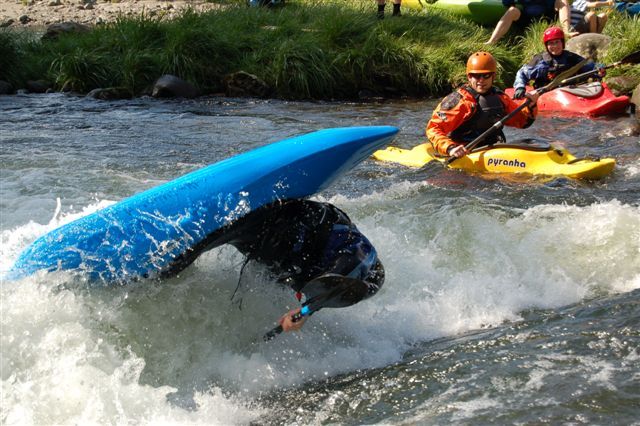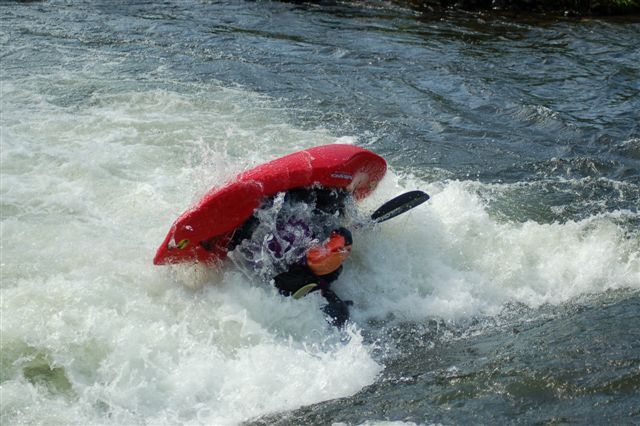Mar 12 2009
My Boats
MY FIRST WHITE WATER BOAT – THE MIGHTY415
The 415 is a Medium volume touring and general purpose short plastic.
13′ 7″ x 23.6″ (415cm x 60cm)
41 lbs (18kg)
Complete with notch type multi-position footrests, short etha foam buoyancy blocks at bow and stern, separately moulded chamber seat with back strap, aluminum strengthening rib in hull, and end toggles.
Its a super easy boat to paddle in Grade 1-3 and goes Ok on the flat. I paddle this boat on my maiden Avon Descent and it also took my mate Graza down his first Avon…so its kind of a virginity breaker.
THE WAVE HOPPER
My newest DownRiver Racing boat the Wavehopper is designed and built by Perception. A French design, built to combine the speed of downriver race boats and the durability of Perception’s MT-2000 super-linear polyethylene whitewater kayaks. Provides the “on-the edge” performance of wildwater racing and it can take the hard knocks of regular whitewater paddling. Basic Dimensions
13′ 2″ Long (4.01m), 24″ at the widest (the hips/wings), about 18kg and total volume of about 360l (90 Gallons). Means its really stable in and punches most holes and stoppers with ease. It’s great to lean into turns and goes pretty good on the flats.
Its Red too which makes it heaps faster ….
THE RPM by DAGGER.
..all round the best boat ever designed.
The Hype from Eddy Flower Website:
If you took every RPM ever sold and lined them up, you’d have a whole lotta irate paddlers standing around. Seriously though folks, the RPM remains the best selling kayak ever. That’s ever. Wanna know why? It starts with a stable and forgiving design that makes the RPM ideal for beginners who seek a versatile river runner with a displacement hull. Add carving performance and solid front and back surfs with dynamic stern squirts and you can’t go wrong. Just for good measure, you’ll also get a thermoformed seat and adjustable backband. The classic paddler loves us for this one.
| Year Introduced | 1996 |
| Type | River Runner |
| Length | 8′ 11″ |
| Width | 24.00″ |
| Volume | 60.00 gallons |
| Weight | 39.00 pounds |
| Cockpit Size | 34″ x 19″ |
| Paddler Weight | 110 – 230 lbs. |
THE BLISS STICK FLIPSTICK
| The Hype from Eddy Flower Website |
|
Simply a wicked playboat. Short and radical, the Flip-Stick will not limit even the top paddlers. Loops become within reach of intermediate paddlers, and yet a great river boat. Short, light and maneuverable. Heaps of rocker keeps the bow from burying and provides additional foot room and comfort. The design brief was a freestyle boat that didn’t limit the boater from executing the latest moves, specifically those than involve air, and a freeze frame video replay to comprehend. All freestyle moves are achievable. The short length makes rotations very fast which takes a little getting used to, but puts loops within grasp of the recreational paddler. Down river, very responsive with enough volume and rocker to stay on top of it all.
What can I say its a Legend.
Others
The Weenie Wave….great for my 6 and 8 year olds to have fun on
The Shearwater Hybrid – Stitch and Strip build, which I am about 50% through. The Hulls all done just the strip planking to sort out…Work In Progres









